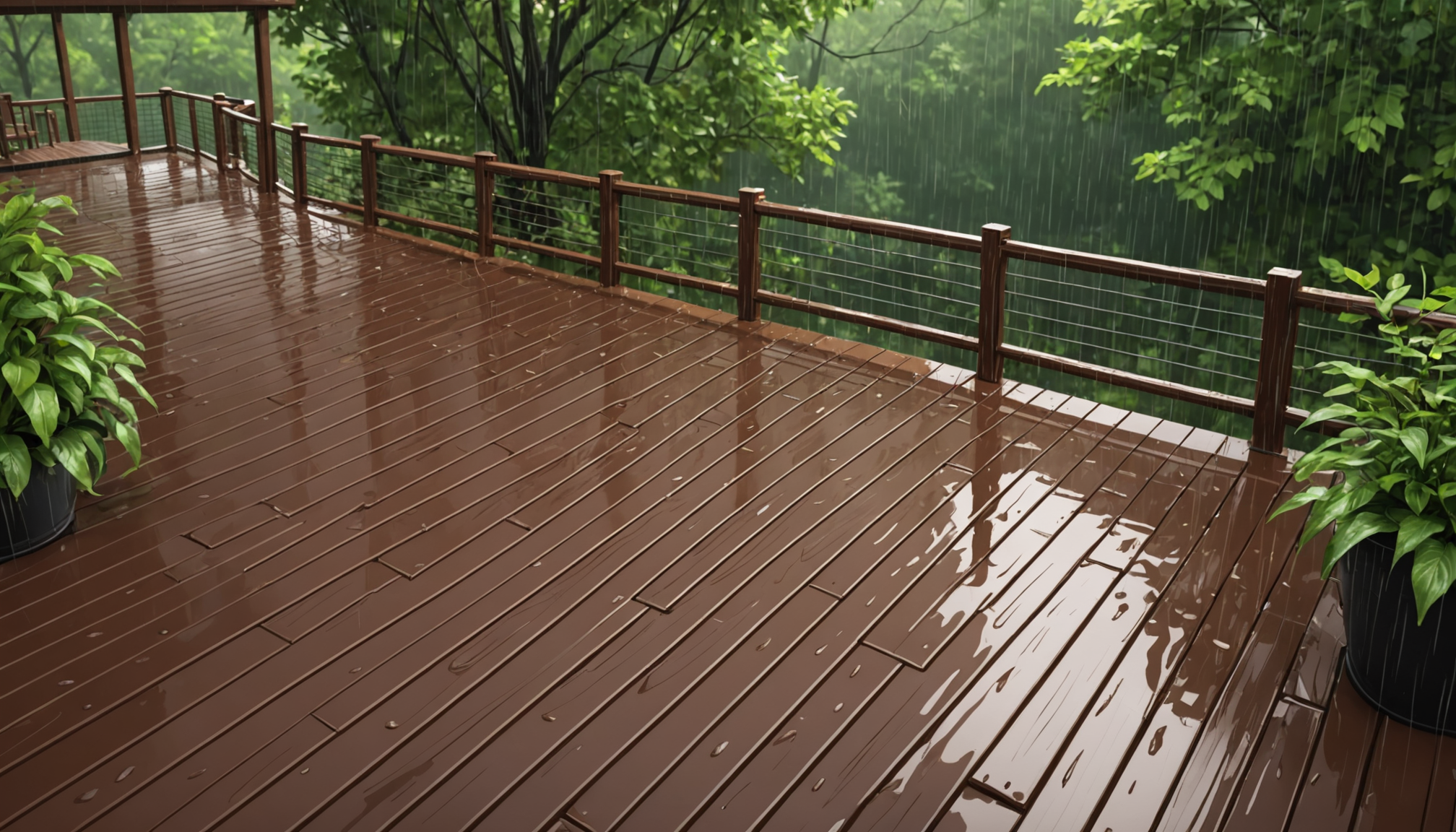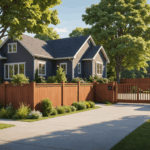When embarking on a decking project, the choice of materials is paramount to ensuring both safety and longevity. The materials you select not only affect the aesthetic appeal of your deck but also its performance against various environmental factors. A well-chosen material can transform your outdoor space into a secure sanctuary that withstands the tests of time and nature.
Among the most popular materials used for deck construction are wood, composite, and PVC. Each comes with its own set of benefits and potential drawbacks, so understanding the nuances of each option is crucial:
| Material | Pros | Cons |
| Wood |
|
|
| Composite |
|
|
| PVC |
|
|
Wood continues to be a classic choice for many homeowners due to its natural charm and relatively low cost. However, it does necessitate vigilant maintenance to prevent deterioration and maintain its secure surface. This includes seasonal sealing, staining, or painting to fend off weather elements and potential pests.
Alternatively, composite materials offer a blend of wood fibers and plastics, providing a balance between aesthetics and longevity. Many eco-conscious homeowners appreciate composites due to their ability to reuse recycled materials, offering a sustainable choice without sacrificing quality. This material often comes with added treatments that enhance its resistance to mold, reduced warping, and minimal splintering, creating a comfortable and secure walking surface.
PVC is rapidly gaining traction due to its superior resilience against moisture and the elements, making it especially suitable for regions with heavy rainfall or humidity. While it may lack the traditional look of natural wood, the low maintenance requirement and extended lifespan more than compensate for this drawback. It’s worth noting, however, that not all PVC products are created equal, so it’s essential to evaluate the manufacturer’s reputation and any warranties offered.
In addition to these main options, other materials like aluminum or even hybrid materials with synthetic and natural components may suit specific needs or environmental considerations. Aluminum, often used for decking frames or additional structural support, is robust, lightweight, and does not corrode. Its integration into the deck design can add a modern touch while enhancing the deck’s overall strength.
Ultimately, selecting the right decking material comes down to balancing aesthetics, budget, maintenance willingness, and environmental impacts. Consulting with professionals or conducting thorough research on material longevity, cost analysis, and regional durability can help ensure that your investment leads to a deck that is not only visually appealing but also eco-friendly and secure.
installing secure railings
When it comes to securing your deck, installing the right railings is crucial, as they provide both safety and style. A well-installed railing can prevent accidents and enhance your deck’s overall aesthetic, offering peace of mind for you and your family. Here’s a step-by-step guide to help you navigate the process of installing secure railings:
- Choose Your Railing Material: The first decision is selecting the material for your railings. Popular options include wood, metal, and composite materials.
- Wood: Traditional and versatile, wood can be painted or stained to match your deck. However, it will require regular maintenance to prevent rot and maintain structural integrity.
- Metal: Aluminum and steel railings offer a modern look and are highly durable and low-maintenance, ideal for heavy-weather conditions.
- Composite: Blending wood fibers with plastic, composite railings are eco-friendly, low-maintenance, and resistant to the elements, perfect for sustainable building projects.
- Measure and Plan: Precise measurements ensure a perfect fit, avoiding weak spots that could compromise safety.
- Use a measuring tape to determine the total linear feet of railing needed for all edges of your deck.
- Decide on the spacing between balusters (generally no more than 4 inches apart) to ensure compliance with building codes and maintain a secure barrier.
- Mark the intended placement of posts and ensure the layout fits your design vision while maintaining structural support.
- Secure the Posts: The posts are the backbone of your railing system and need to be securely anchored.
- Start by installing the posts at corners and where two sections of railing meet. Use a post base to anchor them securely to the deck floor or frame.
- Ensure that the posts are plumb (vertically aligned), using a level for accuracy.
- Fix the posts with lag bolts or a mounting bracket, checking local code requirements to confirm suitable installation methods.
- Install the Railings: After the posts, it’s time to attach the horizontal rails and balusters.
- Begin by attaching the bottom and top rails between the secured posts. Use a railing connector for a cleaner look and stronger connection.
- Cut the rails to size if necessary, ensuring they fit snugly and securely.
- Next, insert and attach balusters between the rails. Make sure they are evenly spaced and secured with screws or brackets.
- Finish by installing a top cap rail if desired, for an added layer of style and protection.
- Check Stability and Finish: Ensure everything is stable and has a polished finish.
- Inspect each connection to verify there are no loose screws or bolts.
- Give the railings a push and pull to check for stability; they should not wobble or move under pressure.
- Sand down any rough edges or exposed cuts if using wood to prevent splinters.
- Apply a sealant or paint as necessary, particularly for wood materials, to protect against weather and extend longevity.
Ensuring the quality and safety of your railing installation not only secures your deck but also enhances its visual appeal. Following these steps with precision and care creates a lasting and secure outdoor space perfect for relaxation and entertainment.
preventing slips and falls
To safeguard against slips and falls on your deck, implementing comprehensive strategies is essential. Creating a secure environment begins with choosing suitable materials that promote traction. Opt for surfaces with inherent slip-resistant properties, such as those with textured finishes, which are particularly beneficial in areas prone to rain or snowfall. Composite and PVC materials often feature built-in slip-resistant qualities, enhancing safety while simultaneously reducing maintenance needs.
Positioning outdoor mats at entry points or high-traffic areas can further mitigate slip hazards. These mats should be made from durable, weather-resistant materials that provide additional grip even when wet. Additionally, securing them appropriately ensures they remain in place and do not become a tripping hazard themselves.
Ensuring proper drainage is another critical component. Allowing water to pool on the deck can create a slick surface that endangers its users. Ensure that your deck is slightly sloped away from the house, directing water towards an effective drainage system. Regularly clean out gutters and downspouts to prevent clogs, especially during the rainy season or after heavy leaf fall in autumn.
Moreover, keeping your deck well-lit is paramount in reducing the risk of accidents, especially in the evenings or during low-light conditions. Install solar-powered or low-voltage LED lighting along the deck perimeter, stairs, and pathways to illuminate these areas effectively. Not only does this enhance visibility, but it also adds an inviting ambiance to your outdoor space.
Incorporating shatterproof glass or sturdy plexiglass as part of your deck’s railing system offers another layer of protection. This prevents individuals, especially children, from sticking their limbs through spaces and provides a wind barrier that keeps the deck more comfortable to use. Ensure that these materials are securely fastened and regularly inspected for any signs of wear or damage.
Fostering a culture of maintenance is imperative. Regular inspections allow you to identify potential issues such as loose boards, protruding nails, or decaying wood that could contribute to accidents. Address these problems promptly, replacing worn-out components and securing loose elements to maintain a safe environment.
Consider seasonal treatments, such as applying non-slip coatings before winter or rainy seasons, to enhance the deck’s surface grip. These treatments are particularly effective for wooden decks, which may become slick over time due to moss or mold growth.
Overall, by implementing these strategies, you can significantly reduce the risk of slips and falls, ensuring that your deck remains a secure haven for relaxation and entertainment. Engaging in preventive measures not only elevates safety but also bolsters the longevity and enjoyment of this cherished outdoor space.
weatherproofing for durability
Ensuring your deck stands the test of time involves more than just selecting durable materials; it also requires proper weatherproofing strategies. These measures protect your deck from the elements, enhancing its durability and maintaining its beauty. To start, consider applying a high-quality sealant to your deck surfaces. Sealants act as a protective barrier against moisture, UV radiation, and temperature fluctuations, which can otherwise lead to warping, fading, and cracking. Choose a sealant that’s compatible with your deck material and reapply as needed, likely every one to two seasons, to keep your deck looking its best.
Another critical component in weatherproofing is addressing the underlying structure of your deck. Using pressure-treated lumber for the framework and ensuring all fasteners and connectors are corrosion-resistant are both vital steps in safeguarding against deterioration. For homeowners with eco-friendly aspirations, selecting sustainably-sourced sealants and paints is an excellent choice, allowing your deck to remain both robust and environmentally conscious.
Drainage is a crucial aspect of preserving your deck’s integrity. Installing proper drainage systems, such as a sloped deck surface or installing drainage channels, can help direct water away from the deck, preventing moisture accumulation that could lead to rot or mold growth. Regularly inspect and clean these systems, especially after storms or heavy rainfall, to ensure they remain functional.
The sun can be just as damaging as rain; UV rays can cause colors to fade and surfaces to crack over time. Investing in UV-resistant coatings can significantly mitigate this risk. Alternatively, consider incorporating shade elements such as pergolas, awnings, or adjustable canopies to provide your deck with additional defense against the sun’s harsh rays, while also creating a comfortable, shaded retreat.
Additionally, protecting your deck’s railing and stairs from the elements is crucial. These can easily become weak points if left untreated. Applying sealant or paint to your railings will help maintain their structural integrity and appearance. Furthermore, using weather-resistant hardware during installation or replacement can prevent rusting and prolong the life of these components.
In regions where temperature drop during colder months, another factor to consider is protection from ice and snow. Use ice melt products that are safe for your specific type of deck material to prevent slipping without causing damage. Additionally, remember to gently remove snow with a plastic shovel to avoid scraping or gouging the deck surface.
Overall, an effective weatherproofing routine involves a blend of careful material choice, regular maintenance, and proactive updates to your deck’s defenses against environmental extremes. These practices not only secure the deck from premature aging and damage but also ensure that it remains a welcoming and thriving outdoor space year-round. Remember, a well-cared-for deck not only adds value to your home but also provides a safe and sustainable area for endless enjoyment.
regular maintenance practices
A well-maintained deck is essential not only for aesthetic appeal but also for ensuring the safety and longevity of your outdoor space. Regular maintenance practices prevent minor issues from turning into costly repairs and ensure that your deck remains a secure and inviting area for relaxation and entertainment.
First, conduct periodic inspections to identify any potential issues. This involves checking for loose or protruding nails, splintered or warped boards, and signs of rot or insect damage. Address these problems promptly by either repairing or replacing damaged sections to maintain a smooth and safe walking surface. It’s vital to use weather-resistant materials for replacements to prolong their durability.
Seasonal cleaning is another critical aspect of deck maintenance. Debris such as leaves, twigs, and dirt can accumulate and retain moisture, leading to mold and decay. Sweeping the deck regularly and washing it with a mild detergent and water will remove this buildup, reducing slip hazards and preserving the deck’s appearance.
It’s also important to apply a fresh coat of sealant or stain every couple of years, depending on exposure to the elements and the material used. This practice not only rejuvenates the deck’s look but provides a protective barrier against moisture, UV rays, and temperature fluctuations, thus preventing cracking and fading.
Additionally, ensure all hardware, such as screws and fasteners, remain in good condition. Rust can weaken connections, posing safety risks. Replace any corroded elements with stainless steel or galvanized alternatives for a secure and long-lasting fix.
If your deck includes electrical components such as lighting, ensure these systems are regularly checked for safety compliance. Keep wires and fixtures in good repair to prevent potential hazards, especially in wetter conditions when electrical issues can pose increased risks.
Incorporating eco-friendly practices can also be part of your regular maintenance routine. Using environmentally friendly cleaning products and sealants protects not only your deck but also the surrounding landscape.
By committing to regular maintenance practices, you ensure your deck remains a vital, secure, and aesthetically pleasing component of your home. These efforts safeguard your investment, providing a safe and sustainable outdoor area you and your family can enjoy for years.
In conclusion, securing your deck involves a comprehensive approach, from choosing the right materials and installing railings, to preventing slips and falls, weatherproofing, and engaging in regular maintenance. By paying close attention to each of these aspects, you’re not only enhancing your deck’s safety and longevity, but you’re also creating a welcoming and sustainable outdoor space tailored to your lifestyle. Remember, a secure and well-cared-for deck is a joy to have and a testament to your home’s enduring appeal and functionality.


